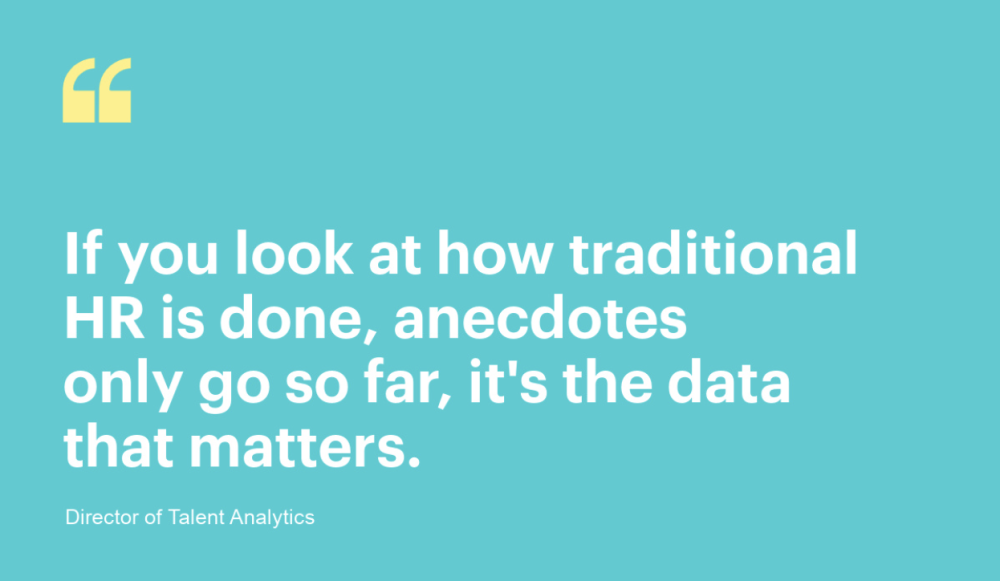
Customer story
Technology
Major Manufacturer
This manufacturing firm is the US arm of a major global manufacturer
Summary
Industry: Technology North American Headquarters Employees: North America: Over 25,000 employees Products: Visier People® Organization, Talent, Talent Acquisition, Planning Challenge: Getting beyond the survey and using data to drive real change. Solution: Longitudinal studies and more sophisticated data insights yield long-term results
Visier Solutions
Industry: Technology
North American Headquarters
Employees: North America: Over 25,000 employees
Products: Visier People® Organization, Talent, Talent Acquisition, Planning
Challenge: Getting beyond the survey and using data to drive real change.
Solution: Longitudinal studies and more sophisticated data insights yield long-term results
A large North American firm which manufactures sophisticated electronics equipment has a combination of manufacturing and research hubs around the world. This organization knows how to value analysis over guesswork and their talent analytics team wanted to prove the value of making solid business decisions based on people data.
This organization needed to find a way to connect a better employee experience with better business outcomes, but they realized that the existing employee experience surveys, which were executed globally via corporate offices outside the US, weren’t providing the level of tactical nuance needed to support this. The US arm needed more and better data.
“Our employees most definitely didn’t just wake up one morning and say, ‘I want out of here,’ or ‘this is not good enough for me.’ There had to be historical trends. There had to be something there that drove them to that point of departure,” explains the talent analytics team’s leader. “We know people are turning over because they’re not satisfied with their job. Let’s take another step back. How does well-being play into that? Let’s take another step back. How does DEI, diversity, equity and inclusion play into that? Let’s take another step back. How does employee segmentation play into all of that? Once we ask these questions, we can ultimately start crafting some longitudinal studies that really look at our employee population behavior and start predicting some of their behavior as well in terms of the initiative.”
Productivity’s diminishing returns curve
The first project they tackled was attrition. The team set up their own employee experience research series to obtain the data and map the employee journey to uncover patterns. In the first 360 days of an employee’s tenure, they conduct five-to-seven surveys of both the employee and the manager to see if there’s a good match on the talent acquisition side. They looked into what was driving turnover and how to predict (and eventually influence) those factors. Gathering historical trends improved the accuracy of predictions.

This North American arm of a global manufacturer leveraged the power of data to institute real change for their employees
Productivity, looking at the number of goods produced with and without defects and correlating these to overtime, is critical within manufacturing. By analyzing normal patterns of overtime, they were able to show that there’s a point of overtime at which defect numbers go up and good units produced go down. Finding the point at which more overtime isn’t increasing productivity helps production lines institute useful policies.
The same proved true of hiring in general. Management had the idea that more bodies equals more units produced indefinitely, but there wasn’t data to back that up. About six months ago, the team did some research and proved a diminishing return curve. By proving that eventually productivity tapers off, management could ease off the gas pedal of hiring. The money spent on talent acquisition could then be used for more meaningful programs.
Proving the link between job satisfaction and turnover
Data also revealed patterns in how leadership at different levels impacted longevity and productivity of employees. While individual data is anonymized to protect employees, the data did reveal that some managers’ teams were less productive. Every insight leads to new questions; the team has begun to test more hypotheses which help business leaders make good decisions about policy. For example, when they surveyed employees about COVID mandates and asked if they correlated with turnover intention, the needle barely moved. No matter what the mandate, the turnover intention barely changed. “But even though the turnover intention didn’t change, job satisfaction dropped significantly. And the net promoter score dropped significantly,” shares the team leader. “So while rolling out a mandate doesn’t make people quit immediately, the fact that they’re not happy with their job and they’re not happy with the company is going to drive them out the door eventually.”

“If you look at how traditional HR is done, anecdotes only go so far,” states the team leader. “It’s the data and analytical insights that matters.” We use several methods, including a combination of Visier and a legacy statistical package, to analyze data. The insights gained help them make targeted decisions to affect turnover. For example, the leadership team wanted to do something to improve employee well-being, but driving changes comes from the data focus. By showing the leaders the insights pulled from Visier about predictive turnover, and from SPSS (a statistical software) telling them employee experience, the talent analytics team has been able to convincingly persuade them to institute changes employees had been asking for such as floating holidays, financial well-being offerings, and additional employee assistance programs. They are currently testing that a workplace that focuses on well-being balanced with productivity does better than one that focuses on productivity only. They are seeking proof that employees do better and feel less wrung out when they have that balance.
People analytics isn’t just about insights, it’s about implementing results
Here are three of the major changes the firm has implemented thanks to the insights gleaned from people data insights:
1. Universal recognition program in North America
Data insights proved to leaders in North America that peer recognition improves employee engagement. Everyone is on the same recognition platform now.
2. Remote work for office workers
Data insights convinced the C-Suite to continue the remote-work policy after COVID to improve morale and reduce attrition.
3. Well-being
Employees had been asking for more financial well-being and mental health support. The people analytics team has been able to prove the value of these programs.
Change management must include human conversations
Speaking the truth, no matter how uncomfortable, opens the door for change management. It’s not just about technology, it’s about shaping conversations. “Change management is a critical success factor in making any technology effective, and people analytics is one of those,” the leader says. “One of the things we learned when we rolled out Visier, it was never about the comfort of tech, it was about who was in the room when we had that onboarding conversation.”
While Visier’s suite of products provides an advantage, any company’s leaders can make great strides simply by changing their mindset and being able to make data-based decisions. Proving the value of using data insights has moved the firm from a novice dipping its toes into the people data arena to a more experienced practitioner with an edge over its competitors.
Results
Proved diminishing return with overtime and productivity
Used data to link job satisfaction and turnover
Saw return on investment with recognition programs